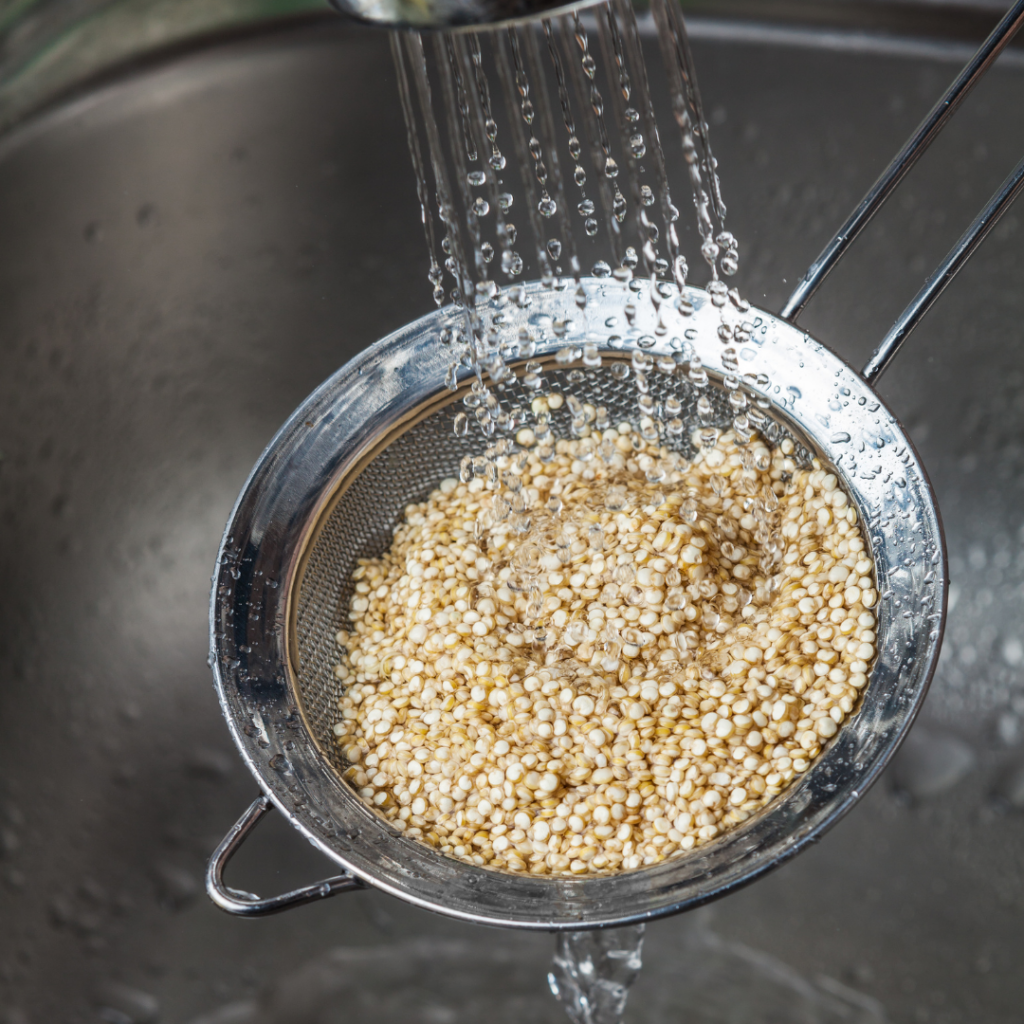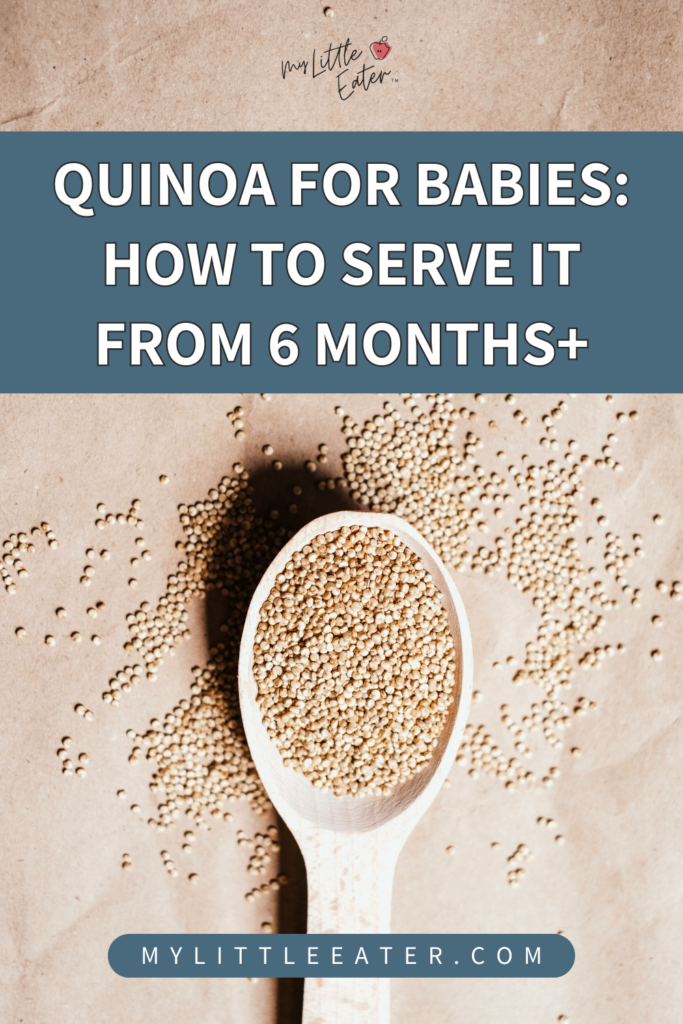Though technically a seed, quinoa is classified as a whole grain. It’s a great option to switch things up for dishes that typically call for rice – with the added benefit of providing more variety, a new flavor, and reducing your baby’s exposure to rice/rice products and the arsenic that comes with them.
Additionally, quinoa is a good source of plant-based protein and fiber and it even contains some iron which is a crucial nutrient for babies (1).
That said, the loose, grainy texture of quinoa can cause some increased gagging and can be difficult for babies to pick up (don’t worry we have tips for that!).
Table of Contents
When can babies eat quinoa?
Quinoa is safe for babies to have from around 6 months old when they’re showing all of the developmental signs of readiness to start solid foods.
It’s a great option because it offers a unique texture experience for babies, one that is not found in many other foods. Offering lots of exposure to various textures like this is beneficial for preventing picky eating down the road.
Watch baby Hannah eat quinoa!
Watch baby Hannah eat quinoa!
Hannah is 6 months old and enjoying quinoa porridge on a preloaded spoon.
Can babies digest starches like quinoa?
You may have heard some concerns about a baby’s ability to digest starches, such as quinoa, rice, potatoes, etc. However, this isn’t accurate based on the research.
Babies are capable of digesting starch at around 6 months when they’re showing all the developmental signs of readiness for solid foods. There is no reason to avoid starchy foods for babies, in fact, if you avoided all foods that contain starch it would greatly limit the variety of foods available for your baby to eat. Even bananas contain starch!

Learn more about how babies digest starch and why it’s ok to offer from the beginning.
Is quinoa a choking hazard for babies?
Quinoa can elicit some gagging from babies due to its loose, grainy texture that can be hard to keep track of in the mouth. BUT this doesn’t mean that it’s considered a choking hazard.
Quinoa actually has a low choking risk because the grains are so small it would be difficult for them to cause a complete blockage, which is what causes choking. However, there is always a risk (even with purees) so while the risk is low it isn’t impossible, and safe serving techniques should be followed.

Prepping quinoa before cooking
Quinoa has a natural coating on the outside of the seed that protects it from fungus and pests (2). The coating is called saponin and it can make the cooked grain taste bitter if it isn’t rinsed off prior to cooking (2).
A lot of commercially produced quinoa packages will come pre-rinsed, but if the package you have doesn’t mention that, or you purchase quinoa in bulk, it’s a good idea to rinse it anyway (2). Plus, even if it’s been rinsed already, there’s no harm in doing it again.
Some people are more sensitive to the bitter taste. When serving it to a baby for the first time, we don’t want them to have a negative flavor experience, so we recommend that you rinse quinoa for your baby regardless (2).

To rinse quinoa properly, measure out the amount of quinoa that you need for cooking (2). Put the quinoa into a fine mesh strainer – just make sure the holes are small enough that the quinoa won’t pass through it (2). Hold the strainer under cold water for at least one minute, shaking or stirring the quinoa every once in a while to make sure all of the quinoa seeds get rinsed (2).
Remove the quinoa from under the water, give an extra shake to get rid of excess water, and cook it according to package instructions (2).
How to serve quinoa according to the Texture Timeline™
These are the safest, suggested ways to serve food to your baby based on the scientific, developmental, and clinical research and expertise available to date and are vetted by pediatric doctors, speech-language pathologists, and dietitians. However, please note that babies can technically choke on anything, including purees. Always take into account your child’s individual abilities and needs and check with your doctor or feeding therapist on the safety of offering these foods to your baby. Be mindful of how to set up a safe eating environment and please know that all material, opinions, advice, and information found on mylittleeater.com is for informational and educational purposes only. See our disclaimer for more information.
What is the Texture Timeline™?
A tool exclusive to My Little Eater that allows you to start solids with your baby using purées, finger foods, or a mixture of both. We sort all foods into different phases of the timeline based on texture difficulty, presenting multiple ways to serve each food depending on what you and your baby are ready for.
You can start with any phase of the Texture Timeline™. The goal is to always be moving forward on the timeline so that you can advance your baby to more challenging textures in a timely manner. This will allow your baby to develop and practice new eating skills and ensure that they don’t stay stuck on one texture for too long.
Using the Texture Timeline™ can help to prevent picky eating, all while keeping the feeding process enjoyable and less stressful for you because you can ease into the difficult textures that often cause more anxiety and worry.
Texture Timeline Phase 0
Thin purée (Utensil)

Add cooked quinoa to a blender along with a bit of water, breastmilk, or formula. Blend until a thin, smooth purée is achieved.
Serve on a preloaded spoon for your baby to practice using utensils. If your baby isn’t interested in using utensils right away, let them dig in with their hands!
Texture Timeline Phase 1
Blended (Utensil)

Add cooked quinoa to a blender and blend until a thick purée forms (aim for the texture of hummus). Add water, breastmilk, or formula as needed to help with the blending process.
Serve on a preloaded spoon for your baby to practice using utensils. Or, if they’re not interested in using utensils right away, let them dig in with their hands!
Texture Timeline Phase 2
Mixed into a purée (Utensil)

Mix cooked quinoa into a binding purée like hummus, yogurt, or mashed potatoes. This will add moisture and keep all of the little pieces together, making it easier for your baby to manipulate in their mouth, chew, and swallow.
Serve on a preloaded spoon for your baby to practice using utensils. Or, if they’re not interested in using utensils right away, let them dig in with their hands!
Texture Timeline Phase 2
Rolled into a ball (Palmar Grasp)

Mix cooked quinoa into a thick binding purée like hummus, yogurt, or mashed potatoes, then roll 2-3 tbsp of the mixture into a ball.
In the beginning, it may be easier for your baby to self-feed with a ball of quinoa using their palmar grasp rather than using a utensil.
Texture Timeline Phase 3
Loose grains (Utensil)

For a very loose, grainy, and advanced texture, cook quinoa and serve it as is on a preloaded spoon. This will provide your baby with great practice in learning how to manipulate many small particles in their mouth at once.
If your baby isn’t interested in eating from a spoon, dump a small pile of cooked quinoa onto their tray, and let them dig in with their hands!
Can you cook quinoa and store it for later?
Yes! Once quinoa is cooked it can be stored in an airtight container in the fridge for up to 3-5 days (3).
If you don’t think you’ll be able to use it again within that time, you can also store cooked quinoa in the freezer for up to 2 months (3).

Nutritional benefits of cooked quinoa
Quinoa is a highly nutritious food for babies! It’s a good source of non-heme iron and has double the amount of protein than rice!
Quinoa also contains essential nutrients such as (1):
- Fiber to support healthy digestion (5).
- Iron for growth, healthy brain development, and the production of red blood cells (6).
- Calcium for strong bones and teeth (7).
- Magnesium for building strong bones and normal muscle and nerve function (8).
- Zinc for healthy growth, development, and immune function (9).

Fun fact
Fun fact
Unlike most sources of plant-based protein, quinoa is a complete protein (1). This means that it contains all nine essential amino acids that our bodies cannot make on their own (1).
Therefore, the protein in quinoa is more comparable to the high-quality protein found in animal foods like chicken, eggs, or fish!
Can babies be allergic to quinoa?
Quinoa is not one of the top 10 highly allergenic foods and can therefore be introduced alongside other non-highly allergenic foods without having to wait.

Quinoa is also considered gluten-free and is generally well-tolerated by those with Celiac disease (1, 4).
If you suspect that your baby has an allergy, it’s best to consult with your doctor for appropriate treatment, diagnosis, and medical advice.
Quinoa recipe for baby and the whole family
This is a nutritious breakfast that the whole family can enjoy. To modify this for your baby, you can roll the porridge into balls for them to eat with their palmar grasp, serve it on a preloaded spoon, or offer them both and see which one they go for!

This recipe does contain peanut butter, which is a top allergen. Be sure to follow proper allergen introduction protocols if they haven’t been exposed to peanuts before. Learn more about introducing allergenic foods.
For more recipes like this one, check out our 60 Day Baby Led Feeding Meal Plan complete with gradual advancement in textures, step-by-step allergen introduction, weekly grocery lists, and more!

Quinoa Peanut Butter Porridge & Blueberries
Equipment
- 1 medium pot
Ingredients
- ⅓ cup quinoa (rinsed and drained)
- 1 ⅓ cup cow’s milk (315 ml)
- 2 tsp peanut butter (natural)
- ¼ cup blueberries (47 g or 1.7 oz)
Instructions
- Add the quinoa and milk to a pot. Bring to a boil.
- Reduce heat to low and simmer covered until the liquid has been absorbed and the quinoa is tender but still chewy, about 15 minutes.
- Remove from the heat and let stand for five minutes. While the porridge is resting, lightly smash the blueberries between your thumb and forefinger to ensure they are no longer round (as this would be a choking hazard for babies).
- Fluff the quinoa with a fork and mix in the peanut butter well, ensuring there aren’t any big globs left.
- Option 1: Form the quinoa peanut butter mixture into large balls that baby can pick up with their hands. Serve lightly smashed blueberries alongside of it.
- Option 2: Serve the quinoa peanut butter porridge with smashed blueberries mixed right into it, on a preloaded spoon.
Notes
To get instant access to all the foods in the Texture Timeline™ Food Video Library, along with our signature course for starting solids with evidence-based research and expert guidance, enroll in our Baby Led Feeding Program!
Complete with video lessons, printable resources for everything along the way, and an app to access it all at your fingertips, it’s like having a team of feeding experts in your pocket supporting you every step of the way.
Was this helpful? Pin it to save for later!

References
- Angeli, V., Miguel Silva, P., Crispim Massuela, D., Khan, M. W., Hamar, A., Khajehei, F., Graeff-Hönninger, S., & Piatti, C. (2020). Quinoa (Chenopodium quinoa Willd.): An Overview of the Potentials of the “Golden Grain” and Socio-Economic and Environmental Aspects of Its Cultivation and Marketization. Foods (Basel, Switzerland), 9(2), 216. https://doi.org/10.3390/foods9020216
- https://www.foodnetwork.com/how-to/packages/food-network-essentials/how-to-rinse-quinoa0
- https://www.wholefoodsmarket.com/tips-and-ideas/archive/learn-cook-learn-save-quinoa
- Bergamo, P., Maurano, F., Mazzarella, G., Iaquinto, G., Vocca, I., Rivelli, A. R., … & Rossi, M. (2011). Immunological evaluation of the alcohol‐soluble protein fraction from gluten‐free grains in relation to celiac disease. Molecular nutrition & food research, 55(8), 1266-1270.
- Brownawell, A. M., Caers, W., Gibson, G. R., Kendall, C. W., Lewis, K. D., Ringel, Y., & Slavin, J. L. (2012). Prebiotics and the health benefits of fiber: current regulatory status, future research, and goals. The Journal of nutrition, 142(5), 962-974.
- Iron needs of babies and children. (2007). Paediatrics & child health, 12(4), 333–336. https://doi.org/10.1093/pch/12.4.333
- National Institutes of Health. (2024). Calcium Fact Sheet for Professionals. Retrieved June 28, 2024, from https://ods.od.nih.gov/factsheets/Calcium-HealthProfessional/#en1
- National Institutes of Health. (2022). Magnesium Fact Sheet for Professionals. Retrieved June 27, 2024, from https://ods.od.nih.gov/factsheets/Magnesium-HealthProfessional/#en3
- National Institutes of Health. (2022). Zinc Fact Sheet for Professionals. Retrieved June 28, 2024, from https://ods.od.nih.gov/factsheets/Zinc-HealthProfessional/

Bianca Gruenewald, RD
Bianca is a Registered Dietitian and works in a client support role at My Little Eater Inc. She's a proud auntie to her three year old niece and four year old nephew!

Bianca Gruenewald, RD
Bianca is a Registered Dietitian and works in a client support role at My Little Eater Inc. She's a proud auntie to her three year old niece and four year old nephew!

Mallory Roberts, SLP
Mallory is a Speech-Language Pathologist, Infant Feeding Specialist, and Craniosacral Therapist. She's also a busy mom of four little ones!

Mallory Roberts, SLP
Mallory is a Speech-Language Pathologist, Infant Feeding Specialist, and Craniosacral Therapist. She's also a busy mom of four little ones!









